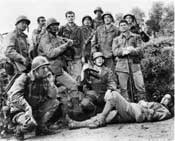 Stop complaining about how difficult it is to encourage well-mannered, highly educated, civilized professionals to work together.
Stop complaining about how difficult it is to encourage well-mannered, highly educated, civilized professionals to work together.
How would you like to transform twelve convicted felons, with an affinity for violence and no desire to work together, into a cohesive, effective team?
That is exactly what Major Reisman is forced to do in E.M. Nathanson’s World War II novel, The Dirty Dozen. The steps Major Reisman takes to create this unlikely team are enlightening to entrepreneurial leaders who seek to unite far more willing team members.
If you haven't already subscribed yet, subscribe now for
free weekly Infochachkie articles!
Team-Building Primer
Ostensibly, the plot focuses on the team’s mission to destroy a high-level German compound, which is miles behind enemy lines. The mission coincides with D-Day, the Allies’ invasion of France, and is intended to cause confusion within the German high command. However, only a relatively small portion of the plot details the actual execution of the mission. As such, The Dirty Dozen is not so much a World War II adventure novel as it is a primer describing how to transform a group of recalcitrant individuals, who have no desire to work together, into a unified, effective team.
The classic phases of team-building, first identified by Bruce Tuckman in 1965, are all present within the formation of the Dirty Dozen (DD). These phases are described in the following chart:
| Teaming Stage |
Initial Thought |
Issues Addressed |
| Forming | “I’m OK. Who are you?” | What’s the “agenda”? Who are these people? Do I fit in? |
| Storming | “I’m OK. You’re not OK.” | Who’s the leader? What’s in it for me? Do I have to do this? |
| Norming | “I’m OK. You’re OK.” | We are a team. I trust the team. |
| Performing | “Our team’s OK.” | Let’s succeed together |
Team-building stages are remarkably consistent, even across various cultures and differing types of teams
Dirty Dozen Team-Building Lessons
Stage One: Forming
1. Drafting The Team
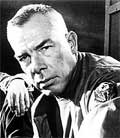 Major Reisman takes great care to interview each potential member of the team in order to understand each individual’s motivations and aptitudes. He learns that the criminal charges filed against several of the prisoners are unjustified, which provides further insight into these soldiers’ characters.
Major Reisman takes great care to interview each potential member of the team in order to understand each individual’s motivations and aptitudes. He learns that the criminal charges filed against several of the prisoners are unjustified, which provides further insight into these soldiers’ characters.
The interviews also help him assess whether or not each prisoner has an appropriate personality to become a productive member of a close-knit team.
Lesson: As noted in Entrepreneurial Entreviewing, it is important to look beyond the superficial facts on a resume and attempt to determine who the person really is, not just what they have done. According to John Petote, Founder and CEO of CIO Solutions, “At the beginning of my venture, I had to hire misfits. They were the only people who would work for a young guy who ran his business out of his apartment.” Just like Major Reisman, entrepreneurs are often forced to hire people with “unconventional” backgrounds during an adVenture’s nascent phases.
2. Success Means Everyone Succeeds
At the outset of the team-building process, Major Reisman establishes the following rule: If one person fails, the entire team fails. If anyone drops out of the program, everyone will be returned to prison to face their sentencing. At one point, one of the team members attempts to escape the training camp. Two of his teammates thwart his efforts because they do not want him to jeopardize the success of the rest of the team.
Colonel Breed, Major Reisman’s antagonist, represents the antithesis of this “collective good” culture. Like a typical employee at a Big Dumb Company, he places his personal success above that of his fellow teammates. Colonel Breed is aptly named, as such employees, left unchecked, can breed a mercenary culture that will undermine your team-building efforts.
Lesson: Defining success collectively instills a sense of “One for all and all for one.” As further described in Do They Believe?, you can foster this sense of shared success by rewarding even the smallest acts through which one member of your team helps another, especially when their personal success is not furthered by providing such assistance.
3. Common Task
Major Reisman requires the DD to build their barracks in the training camp. The faster they complete the camp, the sooner they have a roof over their heads. Despite their antipathy for each other, they are initially brought together by the common desire to not wake up lying in a pool of rainwater.
Lesson: Encourage your team to unite around the accomplishment of a goal that is in everyone’s best interest. This is an effective way to expedite completion of the Forming stage. Be sure to select a task which fosters collaboration, rather than an assignment that can be readily broken into components that can be performed individually.
4. Common Enemies
When the DD are first brought together, each member feels that everyone is their enemy, including the other DD members.
The DD’s first common enemy is Major Reisman. They eventually befriend him and work together against a new common enemy, Colonel Breed. After they “defeat” Colonel Breed, the DD’s common enemy becomes the German Army.
Lesson: As noted in Competing From The Fringe, an effective leader will often coalesce a team around a common enemy. Just as an athletic squad can be motivated to train harder when facing a bitter rival, you can inspire your adVenture to bond around their common loathing of a competitor.
Stage Two: Storming
5. Allow Leaders To Emerge
Major Reisman wisely does not establish an explicit hierarchy within the DD. He allows the team’s leaders to emerge organically. For instance, during the group’s first gathering, a southern bigot insults the lone African American prisoner. A fight ensues. Rather than breaking it up, Major Reisman exits and instructs the military police who are guarding the room to allow the prisoners to “work out their differences.”
Lesson: It is obviously not appropriate in every instance to remove hierarchy from your teams and allow them to fight among themselves. However, in some instances, it is wise to permit your employees to self-select their leaders. In this way, new leaders may emerge within your startup who you otherwise may not have identified.
6. Team Identity
The first sign that the DD is Forming into a team is when they collectively rebel against being forced to shave in cold water. They declare, in unison, that they refuse to bathe or shave until they are given warm water. This revolt results in their “Dirty Dozen” moniker. Rather than angering Major Reisman, he is pleased that individuals are united in their defiance of the cold water policy.
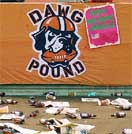
 Lesson: Allow your teams to form their own identity, even down to the name they choose for their team. A name that reflects an inside joke, especially if it has a derogatory meaning to a disinterested outsider, can be a powerful source of group identity. Examples in the sports world abound, including the Cleveland Browns’ “Dawg Pound” and the Green Bay Packers’ “Cheese Heads.”
Lesson: Allow your teams to form their own identity, even down to the name they choose for their team. A name that reflects an inside joke, especially if it has a derogatory meaning to a disinterested outsider, can be a powerful source of group identity. Examples in the sports world abound, including the Cleveland Browns’ “Dawg Pound” and the Green Bay Packers’ “Cheese Heads.”
Stage Three: Norming
7. Us Vs. Then
The DD’s mission is considered a fool’s errand by the senior military leaders who devise the assignment. Although they expect the DD to create a viable diversion, they do not expect any of the members to survive. In many ways, this sentiment echoes the manner in which most reasonable people view startups. Often, the only people who believe that an adVenture will not fail are the members of the adVenture. A fatalistic team, with a defeatist attitude, has little chance of success. The DD’s naivety and unwillingness to acknowledge the risks inherent in their mission keep the team focused on winning.
Lesson: Relish your team’s underdog status, as described more fully in Competing From The Fringe. If properly managed, an “us versus the world” attitude can effectively motivate and coalesce your team around the goal of “proving the world wrong.”
8. Backfill
Each team member is cross-trained to perform one or more of his fellow teammates’ roles. This is an effective hedge against contingencies and gives the Major greater flexibility to deploy his team in a dynamic fashion, as events dictate. This proves to be sound strategy once the team initiates its attack on the German headquarters.
Lesson: Not only is cross-training a prudent management strategy, it also engenders a greater sense of appreciation for the other team members’ roles. It is easier to appreciate the role that others play in an overall mission if you are required to master the assignment yourself. Tasks that are appear simple when viewed as a bystander, become more difficult, when they are carried out as a participant.
At one of my adVentures, my salespeople routinely complained about the perceived inadequacies of our accounts receivable department. They were concerned with how quickly we collected the cash generated by their sales, as I did not pay sales commissions until the cash was received from the customer. To address their concern, I anointed the sales team “collection officers” and gave them the responsibility for collecting past-due accounts. They suddenly gained a new appreciation for accounting and stopped complaining, once they realized that our accounting department was actually doing a credible job.
9. Mission Understood By All
Every member of the DD understood the entire plan, not just the portion for which they were responsible. This was reinforced by a sing-song rhyme that every member of the team was forced to recite until everyone committed it to memory.
The operational mantra comprised sixteen steps, the first five of which are excerpted below.
One: Down to the road block, we've just begun
Two: The guards are through
Three: The Major's men are on a spree
Four: Major and Wladislaw go through the door
Five: Pinkley stays out in the drive
The Major selected this simplistic approach to ensure the men all knew the steps of the mission, as most of his men were poorly educated and a few were completely illiterate.
Lesson: Asking professionals to memorize your company’s mission in the form of a nursery rhyme is not advisable. However, as noted in Core Values, simple mnemonics are effective, even when your team is comprised of educated professionals. Do whatever you can do to facilitate your team’s internalization of your organization’s mission, to ensure that everyone understands all aspects of the company’s overall mission, including those tasks for which they are not directly responsible.
Stage Four: Performing
10. Winning Is The Tie That Binds
Nothing brings a team together like winning. Even the most tumultuous sports teams, such as the 1930s St. Louis Gas House Gang and the late-1970s New York Yankees, focused their aggression outwardly when they were winning and inwardly when they were losing. There was little camaraderie amongst these teams. but both shared a common love of winning.
Before initiating the mission, Major Reisman allows his men to compete in a war games exercise. As noted in Lesson 12: Failure Is Not An Option, their tactics are unconventional and result in a victory that surprises everyone except the Major and the DD. To celebrate their win, the Major allows the men to imbibe and invites a few women to join them. This was a significant gesture, as such rewards were not available to most military prisoners.
By allowing his team to taste victory before setting off on their mission, the Major provided them with a safe environment to test their skills and work together as a cohesive unit. This victory and subsequent celebration played a significant role in the evolution of the DD from a collection of individual, perennial losers into a united, winning team.
Lesson: Allow your team to gain “small wins” along the way to a “big win.” As described in Bang A Gong, you can bind your team by creating a culture of celebration in which even small victories are communicated and celebrated across your organization. In addition, if you recruit team members that share a Humble Pride, the team’s collective desire to win will transcend most petty concerns that may arise between individual teammates.
11. Unity Through Diversity
The DD were ethnically and socioeconomically diverse, especially for 1940s America. The group included an African American, a Russian, an Hispanic, an American Indian, an Italian, an Irishman, a Pole, a Southern religious zealot and a few minor characters of unspecified Western European decent. Such individuals would not even greet each other on the street, let alone work together as peers of their own volition.
Their shared social outcast status and hatred for the army are two powerful points of camaraderie that Major Reisman leverages to create an initial degree of homogeneity within this highly multicultural group. The Major realizes that their “diversity of thought,” not their varying ethnicity, would maximize the team’s ad hoc problem-solving capabilities. Their ability to draw upon a variety of backgrounds and experiences contributes to the team’s ability to effectively carry out their mission, which requires a high level of improvisation and creativity.
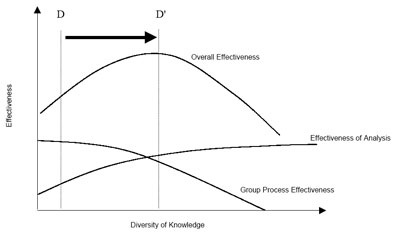
Source: Cohen, Wesley, M. & Levinthal, Daniel - 1990
As Cohen and Levinthal pointed out in 1990, the degree of a team’s diversity of knowledge increases the team’s overall effectiveness up to an inflection point, subsequent to which additional knowledge diversity decreases the team’s effectiveness. In addition, the effectiveness of the group process continually decreases as diversity of knowledge increases. This is highly evident in the DD’s Storming phase, as the team’s diversity creates a significant degree of mistrust and volatility.
Nice theory, but it is clearly impossible to know exactly where the theoretical inflection point lies. Even so, it is helpful to know that increasing diversity of thought often enhances a team’s overall performance, while simultaneously decreasing the overall effectiveness and efficiency of the team-building process.
Lesson: Help your team find points of commonality. One approach is to create cross-functional tasks forces that serve to break down the internal “us vs. them” mentality that can arise at even the healthiest organizations. Placing salespeople, engineers and accountants on the same team will foster cross-departmental cooperation and informal communication channels, which will likely continue long after the team accomplishes its tasks.
Forcing teams with diverse knowledge to work together will be a potentially painful but enriching experiencing. A diverse team is more difficult to manage, but will often generate enhanced outcomes from which your entire organization will benefit.
12. Failure Is Not An Option
Rather than working within the traditional conventions of warfare, the nature of the DD’s mission required them to utilize tactics that classified them as “spies and saboteurs.” For instance, donning German uniforms to infiltrate the German headquarters changed their status from soldiers protected by the Geneva Convention to spies who do not enjoy human rights protections. Instead of being captured as prisoners of war and treated relatively humanely, saboteurs were summarily executed upon capture.
Given the cost of failure, the DD did whatever it took to win. During the war games against Colonel Breed, they switch their arm bands from the “red” team to the “blue” team, as the circumstances dictate. They also steal trucks, munitions and an ambulance to carry out their mission to capture Colonel Breed’s headquarters.
All of these tactics are appropriate, given that the DD were training to be commandoes, rather than traditional soldiers. As such, creatively devising methods to break the rules of engagement was a relevant precursor to their actual mission against their German high command.
Lesson: Your adVenture’s Core Values must be strong enough to guide employees to do “What they should do” not “What they can do.” As noted in Humble Pride, your employees will never consider failure as a viable option if they consider winner a matter of personal pride.
Just Fiction You Say? Think Again
The Filthy Thirteen is often cited as the inspiration for the fictional The Dirty Dozen. The Filthy Thirteen was part of an elite Army commando unit which was selected and trained to destroy targets behind enemy lines. They were assigned to destroy a bridge behind enemy lines during the Normandy Invasion of Europe in June 1944, a mission that cost most of these men their lives.
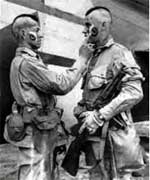 These real-life iconoclasts were not prisoners, but many of them did incur various military infractions including drunkenness and disorderly conduct. They took pride in their slovenly appearance and bragged that they only bathed once a week and never cleaned their uniforms. Given that the casualty rate for groups operating behind enemy lines was as high as 90%, the officers generally turned the other way with respect to such infractions. The price these men were willing to pay with their lives more than offset their minor indiscretions.
These real-life iconoclasts were not prisoners, but many of them did incur various military infractions including drunkenness and disorderly conduct. They took pride in their slovenly appearance and bragged that they only bathed once a week and never cleaned their uniforms. Given that the casualty rate for groups operating behind enemy lines was as high as 90%, the officers generally turned the other way with respect to such infractions. The price these men were willing to pay with their lives more than offset their minor indiscretions.
Similar to Posey, the American Indian character in The Dirty Dozen, the Filthy Thirteen also included an American Indian, Jake McNiece. As shown in the accompanying photo, some members of the Filthy Thirteen donned “war paint” and cut their hair Mohawk-style in homage to McNiece. This eclectic behavior further served to differentiate the team from rank-and-file soldiers.
Ultimately, whether or not the DD’s mission to destroy the Nazi stronghold was successful is not the most important aspect of Mr. Nathanson’s tale. Rather, the real mission was to bring a disparate, dysfunctional group of individuals together as a unified team. To this end, Major Reisman was successful.
If Major Reisman can effectively motivate a group of malcontent, antisocial loners to unite into a cohesive unit, then you can certainly do the same with educated, civil, largely nonviolent entrepreneurs. Unus pro omnibus, omnes pro uno.
—
Copyright © 2008 by J. Meredith Publishing. All rights reserved.




Pingback: Starting Up In A Downturn | infoChachkie
Pingback: Derisk Your Startup By Doing It Again | infoChachkie
Pingback: 10 Reasons To Start A Company In An Economic Downturn